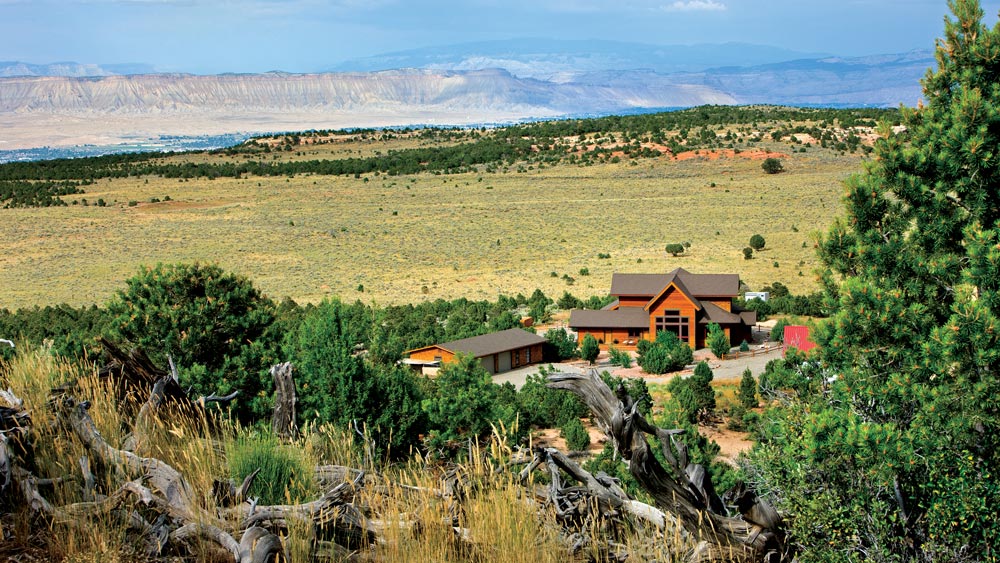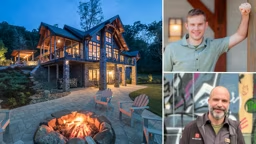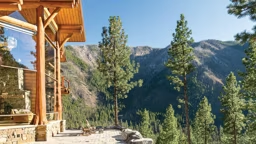
Remote building sites, popular among timber frame homeowners, often end up requiring private roads. See more of this home here. Photo: Roger Wade
What Does It Mean to Live on a Private Road?
"It's all about informed decisions," says Bonnie Pickartz, who co-owns Goshen Timber Frames with her husband, David, in Franklin, North Carolina. "Whether you're building in Colorado, California or the Carolinas, you have to look at the roads. "Roads are so important, not only for your access but from an emergency standpoint. Owners think just because they can get their four-wheel drive in there, it's OK, but if there is inclement weather or there is a fire or health emergency, they can't always get in."
Municipalities, in general, have resisted taking on the financial burden of new roads, which most often are not built to local department of transportation standards, particularly in areas where growth has fueled residential building booms. In other cases, residents themselves prefer a private road because it connotes exclusivity or, at least, provides a certain amount of seclusion. Sometimes the reasons are simply aesthetic.
What Property Can Have Private Roads?
It all starts with access. If you can't get to a piece of property — either for lack of an adequate or legally recorded easement or because the terrain prohibits a cost-effective, practical way to put in a road — it's not the place for your dream home. As you look at property, you may run across lots with easements.What Is an Easement?
An easement can serve as a legal right of way that allows for the establishment of a shared private road. It's critical to understand the scope of an easement — who has access to the road and who is responsible for maintaining it.
It's important to discuss your preferences with neighbors who will share your private road. It's a community resource, so everyone should be involved. See more of this home here. Photo: Karl Neumann
Questions to Ask When Building a Shared Private Road
After reviewing the details of an easement, make sure you have good answers to the following questions:- Who has access into the development and the lot I want to buy?
- Is there an existing road that provides access?
- What will the finished road look like?
- Who maintains it?
- Is there a road maintenance agreement?
- How detailed is the agreement?
- Is there a reserve account designated to hold funds to pay for future maintenance and repair?
- How much will it cost each landowner to maintain the shared private road?
- Do the residents adhere to the agreement?
- Is there a legal remedy, such as the ability to file a lien, if residents don't adhere to the agreement?
"The ordinary development, unless you have some scum who's doing it, will have provisions related to road maintenance," says Richard E. Glaze, a real estate attorney in Winston-Salem, North Carolina. "If there is no provision for maintenance, you're in trouble."
What Is a Private Road Maintenance Agreement?
The most common means for stipulating the details of a shared road maintenance agreement — or any group amenities, such as a swimming pool, club house or walking trail — is a homeowner association, ideally set up in advance by the developer. A Home Owner's Agreement, or HOA, should have detailed covenants or bylaws that address any significant issues.
Cost-sharing typically is split evenly among the landowners, although that isn't always the case. In some neighborhoods, for example, the owner who lives farthest down the road or who has the largest lot, pays the most.
Creating a Private Road Agreement for the Future
The circumstances related to the maintenance of a shared private road certainly can vary. In another case, in Vermont, the developer who oversaw the maintenance of the private road into his development died unexpectedly. He had laid out basic rules for sharing in the maintenance of the hilly, gravel road — named, appropriately enough, Havoc Hill — but with no specifics. There wasn't, and still isn't, a homeowners association. No road maintenance agreement. No details to guide the four owners who are responsible for the road, which is less than a mile long."Then he passed away, so it was just us," says one of the homeowners who asked to remain anonymous for fear of angering her neighbors. "When it's a money issue, it gets sticky because there is nothing formal," she says. It is difficult, not surprisingly, to get a group of homeowners to agree how a road should be maintained when there is no guiding, legally binding document to dictate the terms. Some folks want gravel. Others prefer pavement. "Real Vermonters just drive over the grass until it's worn out," says Patti Komline, another, unrelated homeowner on a private road in Vermont. "It's really weird to see a paved road in Vermont."











